If you just brought home an 8-week-old Labrador puppy, you know you’ve just added dog training to your list of daily chores!
What you might not know is how easy or challenging your new job will be. As the founder of a dog rescue shelter, I have handled many Labradors over the past decade.
To train an 8-week-old Labrador puppy, begin with simple commands like ‘sit’ and ‘come.’ Use treats for positive reinforcement. Keep sessions short, about 5-10 minutes, to maintain their attention. Early socialization is crucial, so expose them to different people, pets, and environments.
I’ve found there are three golden rules when training an 8-week-old Labrador Retriever:
- Train your Lab puppy while he is still young.
- Use consistent training principles.
- Target the five core areas of puppy training.
These three golden rules of Labrador training summarize the details you will find in this article.
I’ll tell you why training your puppy young will yield success, the principles you should follow when training your 8-week-old Lab puppy, and the core training areas you should target as soon as you bring your pup home.
So, let’s go straight into the precise information on training an 8-week-old Labrador puppy.
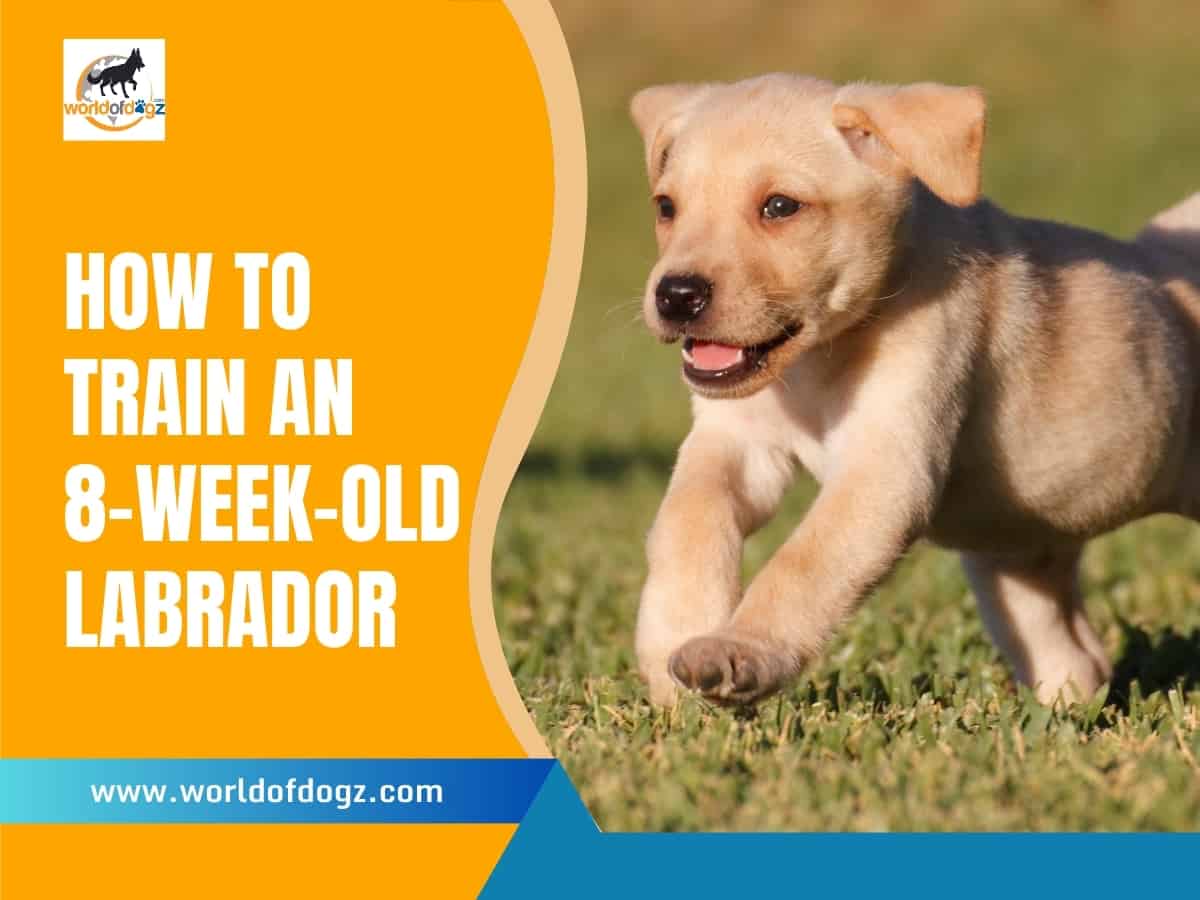
Training Your 8-Week-Old Labrador Puppy
The purpose of any dog training is to have behavioral skills mastered.
As in human training, a good dog trainer understands that the trainee learns better when treated well, using patience, positivity, consistency, and strong regard for the dog’s feelings.
I explain these training requirements in 10 super-easy ways to train a Labrador Retriever puppy.
1. Initiate Your Puppy to Being Handled Gently
Labradors are great at hugs and showing affection. However, they also have to deal with grooming, which can make them feel uncomfortable. Your Labrador puppy can learn to handle this uneasiness if exposed to handling when young.
In one study, puppies who were gently handled early behaved more calmly at eight weeks old than puppies who were not held. You can start gently handling your pup when you bring him home.
2. Teach Name Recognition
How does your Labrador puppy know you are talking to him if you only make commands? You need to teach name recognition as this is the foundation for their future training. Call his name first, then make the command. That way, your pet knows to answer when you call.
3. Let Your Puppy Know That You Are the Alpha
In dog training, your Lab must know that you are the boss from the beginning. If this is done fairly, your puppy won’t do things without first looking up to you and seeking your confirmation.
Never mistake being the boss for punishment. A good leader is fair and doesn’t use fear or physical punishment. An alpha leader teaches the dog to be happily submissive and shows approval for the behavior.

4. Start With Basic Skills and Commands
If you intend to train your Labrador to be a clever pet that hears “AHH AHH!” or “NO!” and refrains from unwanted behavior, you must start with baby steps: teaching basic commands and skills.
Teach your 8-week-old Lab first to obey simple commands such as “NO,” “SIT,” “COME,” “STAY,” and “DOWN.”
Advanced training should only begin at six months old. Check out this guide for more info on command training: The Ultimate Labrador Training Commands Guide.
5. Use Positive Reinforcement
Positive reinforcement or rewards-based training is an integral approach in dog training. Rewards reinforce the behavior, and they can be treats, a favorite toy or activity, and lots of praise.
So, if you are training your puppy to retrieve a ball, affirm him with a “good boy” compliment and reward him with a treat.
By the time the command is executed thrice, your Labrador pup knows that bringing you the ball is a good thing because it also produces good outcomes.
6. Make Commands Only Once
When it comes to training, what you give is what you get. If you train your young Labrador puppy to listen to commands three times before obeying them, that’s exactly what he will learn. This is known as command nagging.
Teach your pup to heed a command at its first mention. If an order is not executed the first time, show your Lab what you want them to do and make the command again. Repeat that until they learn to obey the command the first time it is made.
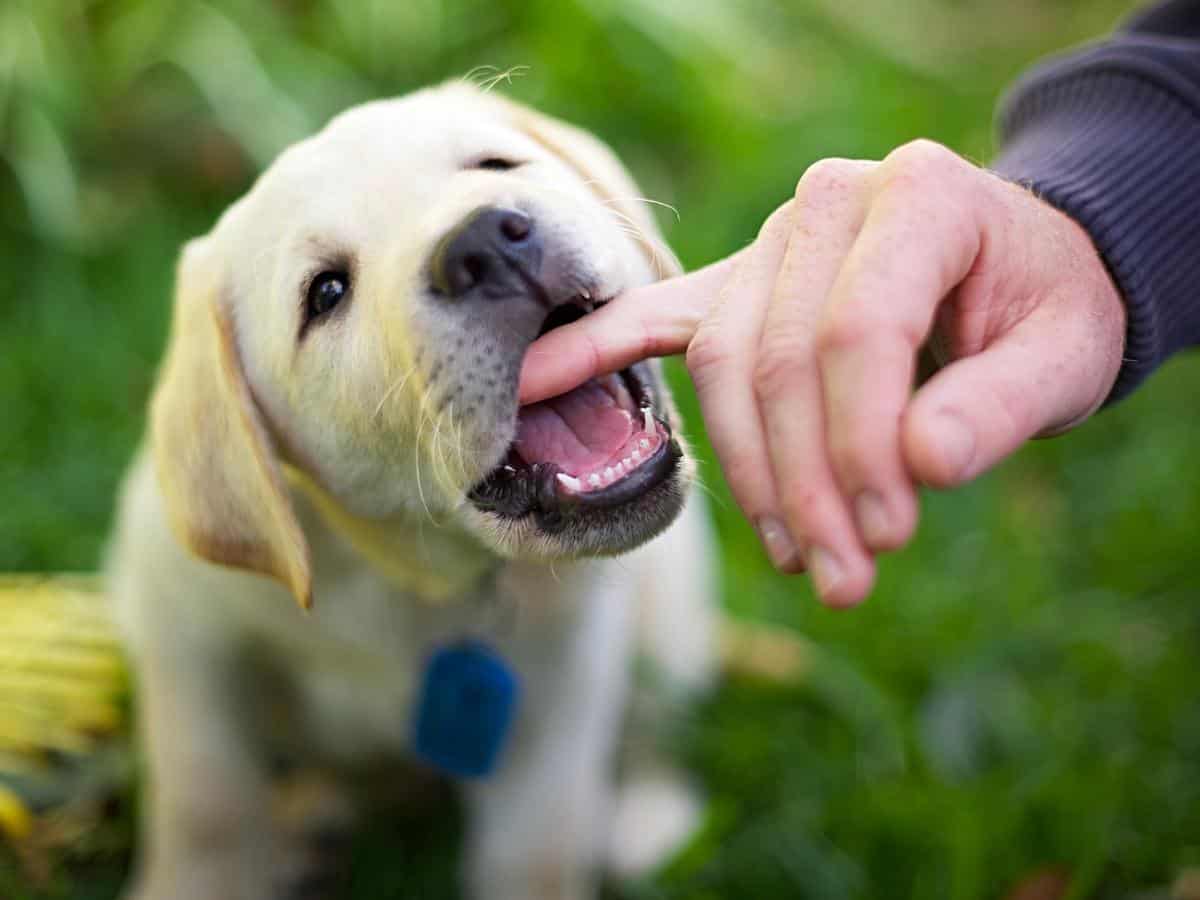
7. Act at the Moment of Misbehavior
Timing is crucial when disciplining your 8-week-old Labrador pup. It’s no good telling him “NO” minutes after the event as he won’t realize what he has done wrong!
Dogs will typically forget an experience in 2 minutes. However, they can recall your training commands through associative memory.
Once your pup has corrected his unwanted behavior with the desired behavior, reward him with a tasty treat and lots of praise.
To learn more about how to discipline your dog, check out my top article, How to Discipline a Labrador: What Not to Do!
8. Don’t Use Physical Punishment or Yell
Never physically punish or yell at your Lab. This only causes fear and distrust, and, as this year-long study conducted by the University of Pennsylvania found, it can also cause aggression in dogs.
Using physical punishment, such as hitting, kicking, or grabbing the jowls and shaking, is simply animal abuse.
Other unacceptable methods are physically forcing the dog down onto its side or back, growling at your dog, withdrawing food, using a shock collar, or tying it for hours.
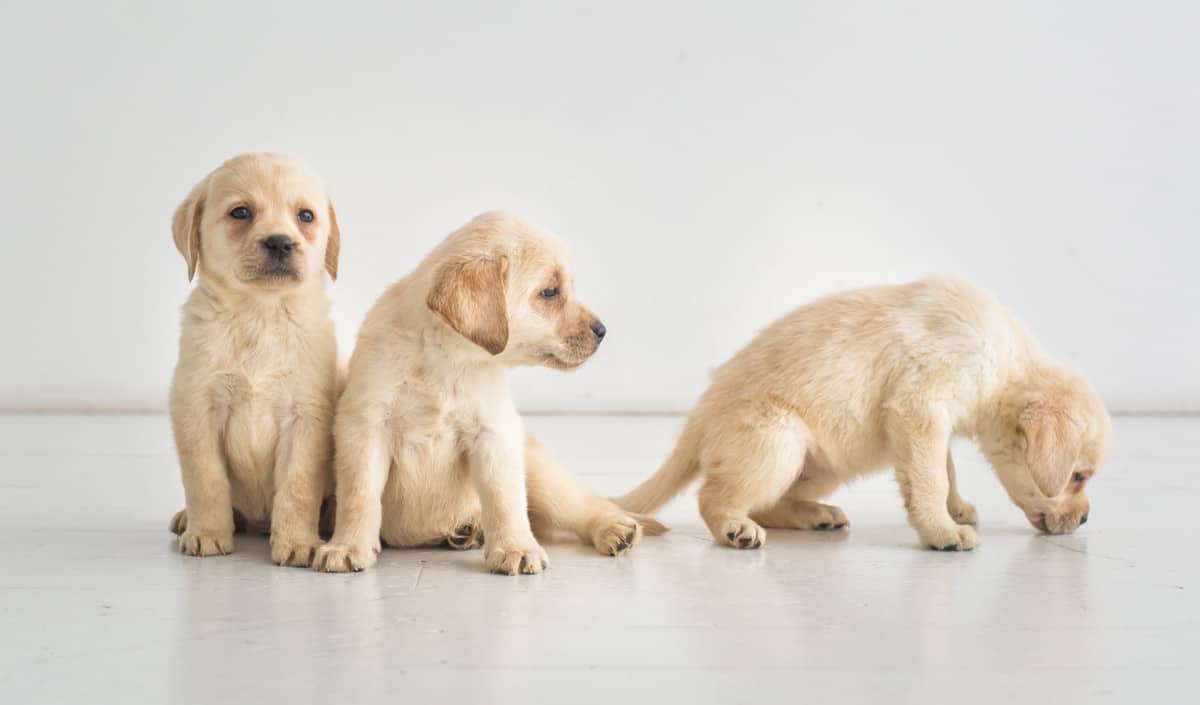
9. Be Consistent in Your Training
If your puppy barks for a treat one day and you say “NO” and withhold it till he is quiet, but you give it to him while barking on a different day, you’ll never achieve any positive results with your training!
Make sure your “NO” always means “NO”; otherwise, your poor puppy will be confused about what you expect.
10. Wean Your Puppy off Training Treats
Your Labrador needs to learn that skills and commands are not learned or obeyed for the sole motive of a treat.
For this reason, it is important to wean your puppy off treats when he has repeatedly performed the behavior and completely mastered it in different locations and with various distractions.
Nonetheless, your Labrador puppy is still a dog in training, and you still need to tell him that he has done the right thing. That could mean rewarding him with lots of praise or a favorite activity such as “fetch” or taking him on his favorite walk.
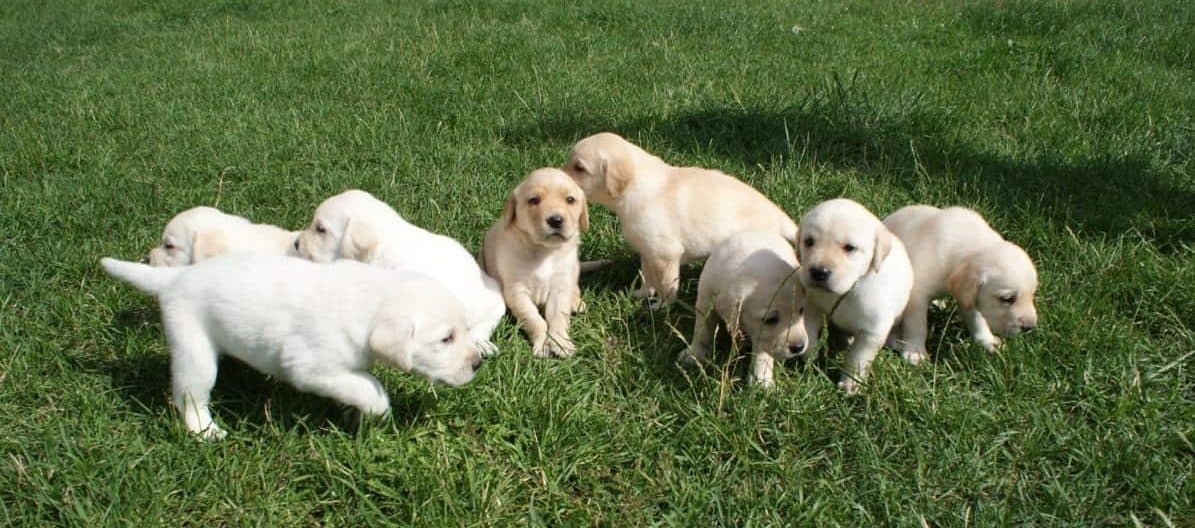
When To Start Training a Labrador
The rule of thumb is that they are trained young in dog training.
You should train Labrador puppies as soon as you bring them home, typically around eight weeks of age.
This does not imply that you cannot train older puppies or adult dogs; it simply means that it’s much easier to train dogs when they are young.
The American Kennel Club (AKC) indicates that the first key milestone when training a Lab pup is eight weeks, as soon as they have left their mother.
When you bring your two-month-old Labrador Retriever puppy home, it has most likely interacted with a few situations and is eager enough to learn and follow the rules of a new home.
A recent study scientifically proved that 8-week-old puppies are quite capable of learning at this young age as they quickly learned to open a puzzle box baited with food and remembered the skill an hour later.
Interestingly, these puppies learned the skill better from a human rather than their mother.
Other studies have also proven that it is effective for future behavior to teach puppies socialization and other skills rather than adults.
In this study, puppies who attended a command and socialization training class for one hour a day for six months responded better to strangers than adult dogs who attended the same classes.
Are Lab Puppies Easy to Train?
Lab puppies are easy to train. They are a working breed that enjoys physical and mental stimulation and have many positive traits.
They are intelligent, devoted, friendly, highly social, and love to please. They are often used as guide dogs, therapy dogs, or search and rescue due to their easy trainability.
Apart from the age factor, other breed-specific reasons make training a Labrador puppy easy. Here are three examples:
- Labradors are among the most intelligent dog breeds. In his book, The Intelligence of Dogs, canine psychologist Stanley Coren lists Labradors in the top tier of the smartest dogs. So, even at just two months, your puppy has it in his blood to learn and carry out commands.
- To perform their original working job of retrieving fish that came off the trawl, Labradors had to be watchful and enthusiastic. These are essential learning characteristics.
- As game and waterfowl retrievers for hunters, Labradors have to be obedient. Another core training requirement makes your Lab puppy easy to train.
These ten principles on exactly how to train an 8-week-old Labrador can now be applied to the key areas your young puppy needs to be trained in.
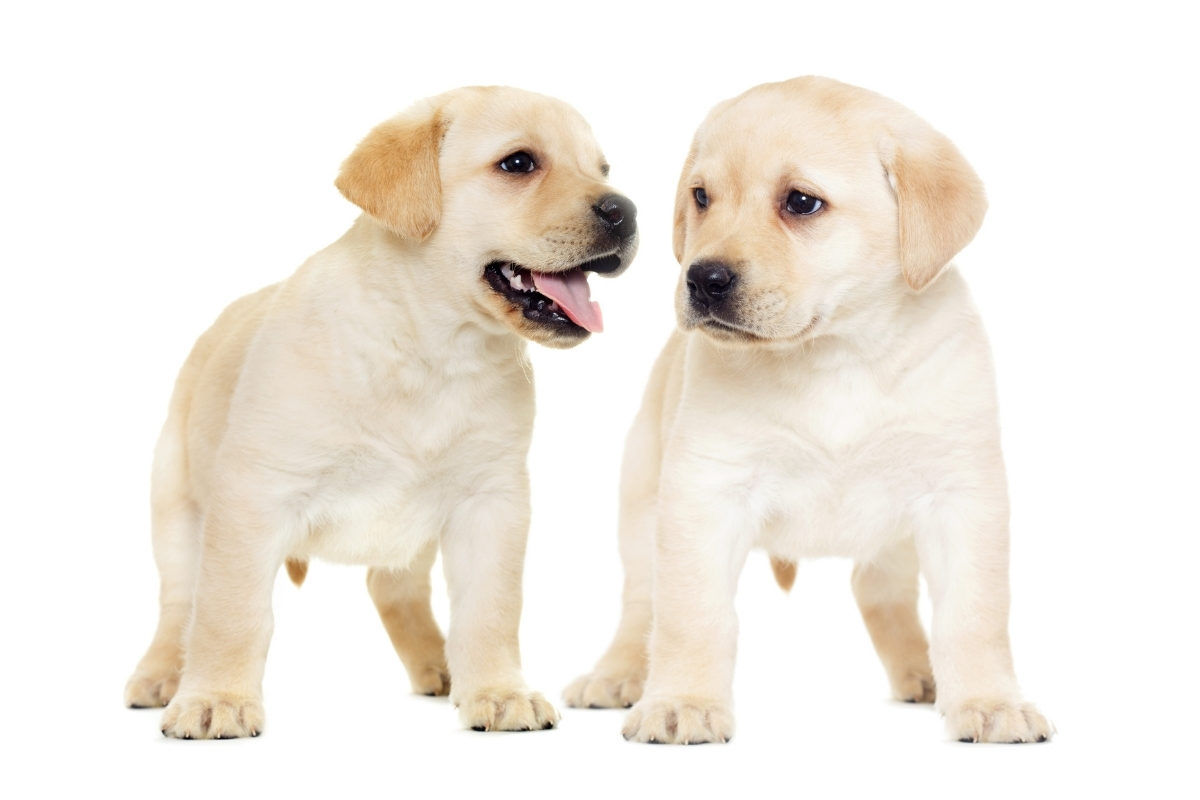
Key Areas of Labrador Puppy Training
You must appropriately train your 8-week-old Lab puppy in five critical areas. In the next section, I will describe the training.
Socialization
They say humans are social beings, but that is also true about dogs. Socialization begins with the breeder and continues with you.
To socialize a Labrador, expose him to many different places and situations. Include sounds, smells, other adults, children, animals, cars, objects, etc.
Make each experience a positive one, and don’t rush the process. Well-socialized dogs, in the first 12 weeks, will be set up for life.
Socializing and training your puppy young plays a significant role in the development of adult dogs, as evidenced in this important study. Here are two key findings:
- Dogs that are well-socialized as pups will behave more positively with humans and are less likely to display unwanted behavioral problems such as fear and aggression.
- Socialized dogs are more likely to engage in positive social behaviors with humans. They also learn better how to play games with humans, helping them establish a true bond with their owners.
As a puppy, you can teach your Labrador social skills and confidence through intentional training moments in the family.
Once he has completed his vaccinations, take him to public places such as parks or puppy socialization classes.
Potty Training
Those tiny packages that your Lab will leave around the house if you don’t teach him where to go are not a pleasant sight or smell!
To potty train an 8-week-old Lab puppy, control your dog’s access to the house by attaching him to you with a leash or putting him in a puppy-proof area.
Put him outside hourly and learn to anticipate when he needs to go. Reward and praise him when he does go outside.
Discover The 5 Most Common Potty Training Mistakes In This Video…
You will also get to know your Lab’s potty routine. Usually, puppies will need to relieve themselves early in the morning and after meals.
Use their natural rhythm for daily pee or poop walks.
Here’s a possible routine you could use to potty-train your new puppy:
- Walk your pup first thing every morning to give him a chance to relieve himself. Dogs hate messing in the area they sleep in and usually hold it. Nonetheless, very young puppies might be unable to do so.
- Walk your Labrador after his morning meal and hang around for 15 minutes or so to allow him to do his thing. Repeat the same in the evening.
- Puppies will need to be allowed to relieve themselves every hour, and for vaccinated dogs, a short walk every 2-3 hours is an ideal routine to prevent them from peeing around the house.
- If you crate your puppy because you need to go out, get someone to help you stick to the routine. Repeating this routine for the first few days will give your new furry friend a good idea of his expectations.
Don’t have unrealistic expectations, as puppies can take a few weeks to master potty training. Check out my guide to Labrador potty training here.
Crate Training your 8 Week Old Lab Puppy
Crate training is an essential element of house training, but it also benefits your Lab’s safety and comfort when he is left alone.
To crate train an 8-week-old Labrador puppy, start as soon as you bring him home. Slowly introduce him to the crate by throwing a treat inside and letting him explore the crate voluntarily.
When you first leave him with the door closed, ensure he is tired, as he will sleep and not be afraid.
PRO TIP! Check out my Best Dog Crates for Labradors (and Playpens) recommendations, including soft crates, travel crates, and furniture styles.
Here are six key things you should practice when crate-training your Labrador:
- Keep your puppy in the crate at night. You shouldn’t let him sleep in your bed, but you can have the crate near you.
- Initiate crate training from the very first day you bring your puppy home. It will be harder to succeed in crate training if your puppy gets used to other sleeping arrangements. You will likely hear your 8-week-old Lab cry during the first night, but don’t worry, as this is normal and expected. My puppy cried during the first night, but she was just fine after that.
- Lab puppies can be left alone in a crate for up to 4 hours or 1 hour for each month of age. For more information, check out this guide: How Long Can You Leave a Labrador in a Crate?
- Keep your dog in the crate when you are out of the house. This is also for his safety, such as when you are cooking.
- Do not let your Lab out of the cage when barking or giving you those puppy eyes. You’ve just sent a message that he can have his way if you do. Instead, reward good behavior in the crate, i.e., as soon as he stops barking. He will quickly learn that being quiet leads to nice things.
- Keep your pup’s crate in the same place to avoid confusing him. He will quickly learn that this special place is just for him. Various toys and bedding will offer some comfort for your Labrador. Cover half of the crate with a blanket to give it a “den-like” feel, as dogs love this.
When purchasing a crate for your puppy, the best ones will give your Lab enough room to stand, sit, turn, and lie comfortably on his side with paws outstretched. A size 42″ is best for Labrador Retrievers.
There shouldn’t be too much room for a 2-month-old puppy to discourage him from pooping down the other end of the crate.
Instead, buy a crate with an adjustable divider that allows him to grow into. Choose a standard metal model with either a single or double door.
My favorite is the MidWest Homes for Pets Dog iCrate from Amazon, as it’s strong and sturdy and ideal for medium-large breed dogs.
It has everything you need and includes a divider and a removable plastic pan that’s easy to wipe clean. It’s also easy to put up, and you don’t need any tools.
Note: Clicking the above link(s) will take you to Amazon or an online store where we have an affiliate relationship. If you make a purchase, we may earn a commission at no additional cost to you.
Travel kennels like this Petmate Ultra Vari Kennel, also from Amazon, are also hardy when you are on the move with your dog. This one is even airline adaptable and meets most airline cargo specifications.
Watch How To Crate Train a Puppy…
To learn tons more on puppy crate training, head over to my step-by-step guide, Easy Labrador Puppy Crate Training.
Preventing Biting and Nipping
Biting is part of being a dog, and it’s completely natural for puppies to want to explore their new world with their mouths.
Older dogs may refrain from biting because they have been trained not to hurt as they have learned their bite inhibition. This simply means that the dog has learned to control the strength of his bite.
To train a Lab puppy not to bite, let out a loud yelp such as “ouch” when he bites, and let your hand go limp. This sends the message that the bite hurts. Persist by leaving your hand in his mouth until he lets go, then use lots of praise.
When your dog gets the hang of repeatedly letting go, this is a sign that he is beginning to learn his bite inhibition, also known as “soft mouth.”
Helping a dog learn to inhibit the force of its bite is paramount to living with humans. All puppies need to master this technique that they initially learned from their mother and littermates.
Learn About Bite Inhibition In This Video…
Training your Lab puppy to soft bite must be done in puppyhood as an adolescent dog will not know how to adjust the force of his jaws when he has adult teeth and adult jaw muscles.
This can be devastating for you both, should your Labrador go on to bite someone!
Have realistic expectations – as it can take your puppy weeks to learn his soft bite.
Walking on a Leash
Walking on a leash is not a natural skill in dogs – they need to learn it!
To train a Labrador puppy to walk on a leash, practice at home first by introducing the pup to a collar and/or harness to let him get used to it.
Teach a leash cue, then introduce the pup to very short walks. If the dog pulls, stand fast and wait for him to return to you before continuing.
Consider the following steps:
- Introduce your Labrador puppy to a harness and/or collar and leash by first allowing him to get used to it gradually. Do this by letting him wear them for short periods inside the house and yard. I find the best no-pull harnesses to be those that are not rear-attached, such as the Walk Your Dog With Love harness. They give you more control and are ideal for medium-large breeds.
- Teach a leash cue to call your pup’s attention when you want to put on the leash or to come to you as a way of learning to walk while on a leash. It could be a “come” while holding the leash, but most dogs will soon learn to associate the sound of you picking up his leash and collar with a walk. Give a treat when the command is obeyed.
- Introduce your Lab to short walks outside on a leash. It’s inevitable your puppy will get distracted and will try to pull. Don’t pull back, but stand still until he comes back towards you. When it appears he is about to lunge toward another dog or object, quickly distract him with a treat. Timing is crucial. Reward him every time commands are obeyed and gradually reduce the rewards as the art of leash walking is perfected.
You can start steps 1 and 2 when the puppy is young, but you can only commence step 3 once the dog has been vaccinated.
Final Thoughts
Eight weeks old is the perfect time to train a Labrador puppy in key areas such as socialization, crate training, potty training, not biting, and leash training.
To successfully train your Lab puppy in these areas, you must follow good training principles such as using reward-based training, being consistent in your commands, and disciplining at the precise moment of poor behavior.
Begin with basic commands before introducing more complex or trick commands. Check out my complete guide, Lab Puppy Training Schedule, to learn what to teach month by month and when you’re ready to move to the next stage.





